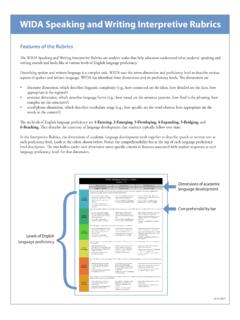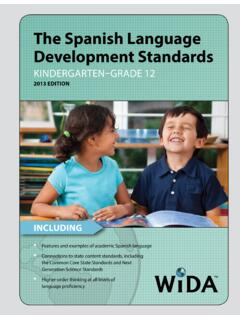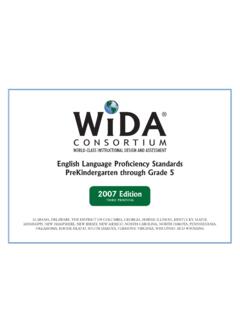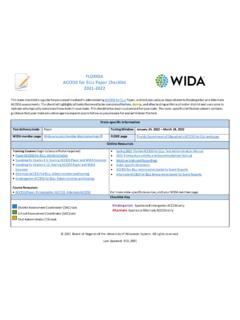Transcription of ACCESS for ELLs Interpretive Guide - WIDA
1 ACCESS for ELLs Interpretive Guide for Score ReportsGrades K 12 SPRING 2020 UNDERSTANDING STUDENT SCORES 2019 Board of Regents of the University of Wisconsin System, on behalf of WIDA. Comments on this document? Email Last revised 3/1/20 Contents Understanding ACCESS for ELLs 1 ACCESS for ELLs Score Reports .. 2 Individual Student .. 2 Student Roster .. 2 School, District, and State Frequency .. 2 Individual Student Scores .. 3 Domain Scores .. 3 Composite Scores .. 6 Understanding Student Growth .. 7 Interpreting Student Scores .. 7 Kindergarten Scores .. 8 Group Scores .. 8 Student Roster Report .. 8 Frequency Reports .. 9 Appendix A: Proficiency Level Descriptors (Grades 1 12) .. 10 Appendix B: Proficiency Level Descriptors (Kindergarten) .. 14 Appendix C: Blank or NA on the Individual Student Report.
2 16 This document helps educators understand what students ACCESS for ELLs scores mean and what to do with that information. It also introduces some of the tools available to program coordinators and district administrators interested in reviewing and taking action on group performance on ACCESS for ELLs. This document presents recommendations from WIDA for interpreting and using ACCESS for ELLs scores. Keep in mind that state and district policies on test score use differ from each other and may vary from the recommendations presented in this document. The Every Student Succeeds Act of 2015 requires that all students identified as ELLs be assessed annually for english language proficiency. ACCESS for ELLs meets federal accountability requirements and provides educators with a measure of the english language proficiency growth of ELLs.
3 1 Understanding ACCESS for ELLs Scores Before diving into your students score reports, take some time to familiarize yourself with the resources on the Can Do Descriptors page of the WIDA website. The Can Do Descriptors and the corresponding WIDA Performance Definitions for Speaking and Writing and Listening and Reading can help you understand what test scores mean in practical terms. As you examine and discuss the english language proficiency profile that each Individual Student Report shows, use WIDA resources to help you move from scores to practical recommendations for the services, instructional support, and future assessment needs of each student. Consider holding an in-service session for your school or district ELL teachers to talk through the WIDA english Language Development Standards, review sample score reports, and discuss how students scores might inform your plans for classroom instruction and support.
4 WIDA also offers a variety of professional development sessions, both in-person and online, that can help educators and administrators better understand and make the best use of WIDA assessment scores, standards, and other resources. Check out the current professional learning offerings and don t miss the annual offerings of a variety of ACCESS for ELLs webinars. Find this year s schedule and recorded webinars in the Download Library in the Secure Portal. Use resources like the Model Performance Indicators, included in the 2012 Amplification of the english Language Development Standards, to identify and describe the language abilities a student already has, the skills a student can work on, and the instructional supports that might be effective as a student develops new language abilities.
5 Share the profile and plans you develop with your students content teachers. Translate your plans into the student s home language and share them with the student s family during conferences, family nights, or home visits so that home can be a place of active language learning. Don t keep ACCESS for ELLs information to yourself! Your students scores can help parents or guardians and other educators better understand a student s abilities. Find resources for sharing ACCESS for ELLs scores with parents on the Family Engagement page of the WIDA website. ACCESS for ELLs is a suite of large-scale english language proficiency tests for K 12 students. It is one component of a comprehensive, standards-driven system that supports the teaching and learning of english language learners (ELLs).
6 The purpose of ACCESS for ELLs is to monitor student progress in english language proficiency on a yearly basis and to serve as just one of the many criteria that educators consider to determine when english learners have attained an english language proficiency level comparable to that of their english -proficient peers. For more information about ACCESS for ELLs, visit ACCESS for ELLs is a standards referenced test, meaning that student performance is compared to english language development standards WIDA has defined. Any student can achieve any score, and students are not ranked against each other or against the expected performance of monolingual english speakers. Visit for more information on using WIDA standards. 2 ACCESS for ELLs Score Reports Individual Student Detailed report of a single student s performance, including proficiency level and scale scores for each language domain and four composite areas.
7 Audience Students Parents & Guardians Teachers School Teams Use Share with students to set language goals. Share with parents and guardians as part of discussions around student progress and achievement. Share with teachers who work with the student to inform classroom instruction and assessment. Student Roster Overview report on the performances of a group of students, including proficiency level and scale scores for each language domain and composite area by school, grade, student, tier, and grade-level cluster. Audience Teachers Program Coordinators & Directors Administrators Use Share with administrators, teachers, and grade-level teams of teachers to inform classroom instruction and , District, and State Frequency High-level reports for a single grade within a school, district, or state on the number and percentage of tested students that achieved each proficiency level for each language domain and composite area.
8 School Report Audience Program Coordinators & Directors Administrators Use Share with school and district staff to inform school-level programmatic decisions. District Report Audience Program Coordinators & Directors Administrators Boards of Education Use Share with district staff to inform district-level programmatic decisions. State Report Audience State and District Program Staff Policy Makers & Legislators Use Use to prepare reports for policymakers and legislators and to inform state- and district-level programmatic decisions. View sample reports at Translated versions of the Individual Student Report are available in WIDA AMS. Available languages include: Albanian, Amharic, arabic (MSA), Bengali, Bosnian, Burmese, Chamorro, chinese (Simplified), chinese (Traditional), Chuukese, french (European), German, Gujarati, Haitian Creole, Hawaiian, Hindi, Hmong, Ilokano, Italian, Japanese, Karen, Khmer (Cambodian), Korean, Lao, Malayalam, Mandingo, Marshallese, Nepali, Polish, Portuguese (Brazilian), Punjabi, Romanian, Russian, Samoan, Serbian, Somali, Spanish (International), Swahili, Tagalog, Telugu, Tongan, Turkish, Ukrainian, Urdu, Vietnamese, and Wolof.
9 Translated reports provided to students families should accompany not replace! official reports in english . 3 Individual Student Scores Domain Scores The Individual Student Report contains detailed information about a student s performance on each section of the ACCESS for ELLs assessment. It is primarily for students, parents or guardians, teachers, and school teams. It provides a snapshot of how well the student understands and can produce the language needed to ACCESS academic content and succeed in school. The Individual Student Report shows both a proficiency level and a scale score for each of the four domains of ACCESS for ELLs. Proficiency levels are Interpretive scores. In other words, they are based on, but separate from, scale scores. The proficiency level score describes the student s performance in terms of the six WIDA english language proficiency levels: Level 1 Entering Level 2 Emerging Level 3 Developing Level 4 Expanding Level 5 Bridging Level 6 Reaching The proficiency level score is a whole number followed by a decimal.
10 The whole number reflects the student s proficiency level, and the number after the decimal reflects how far the student has progressed within that level. For example, a student with a score of is at proficiency level 3, and is over halfway toward achieving proficiency level 4. At the bottom of the Individual Student Report, each proficiency level the student achieved is explained in terms of what the student can do using english . See the Appendix A for a complete list of these proficiency level descriptors. Proficiency level scores are grade-specific. For example, a fifth grader at proficiency level 4 might earn a scale score (see explanation below) of 355. That same scale score for a third grader might translate to a proficiency level score of Proficiency level scores are domain-specific.















